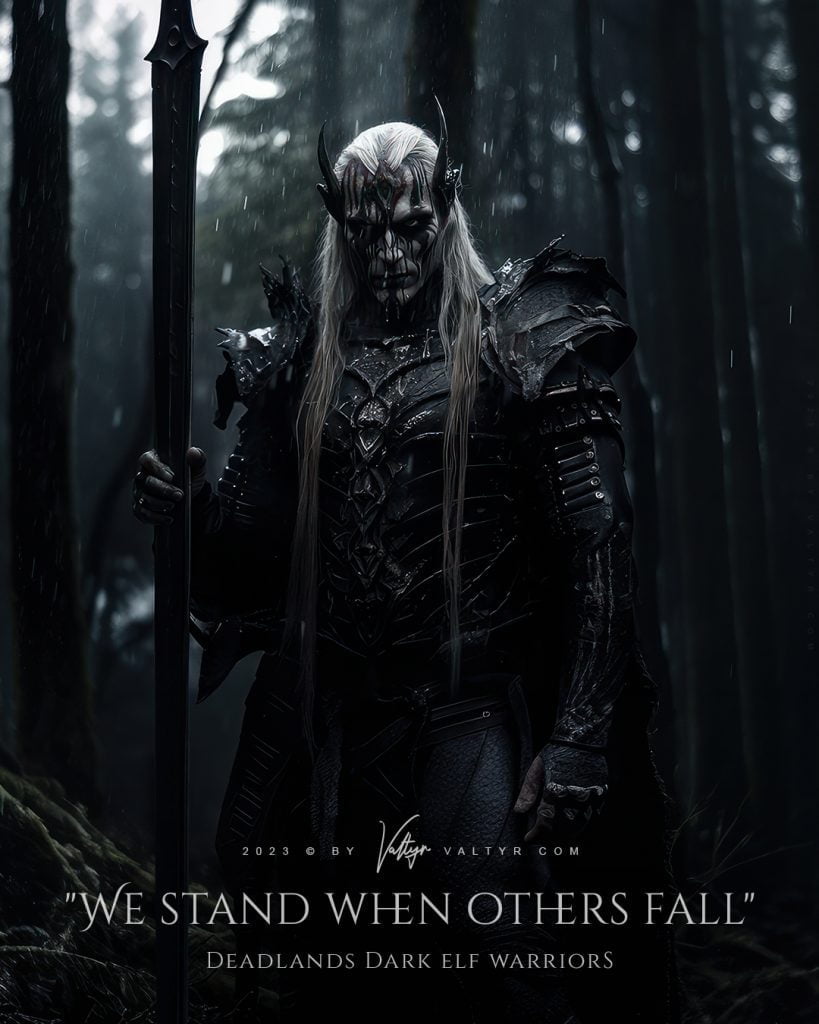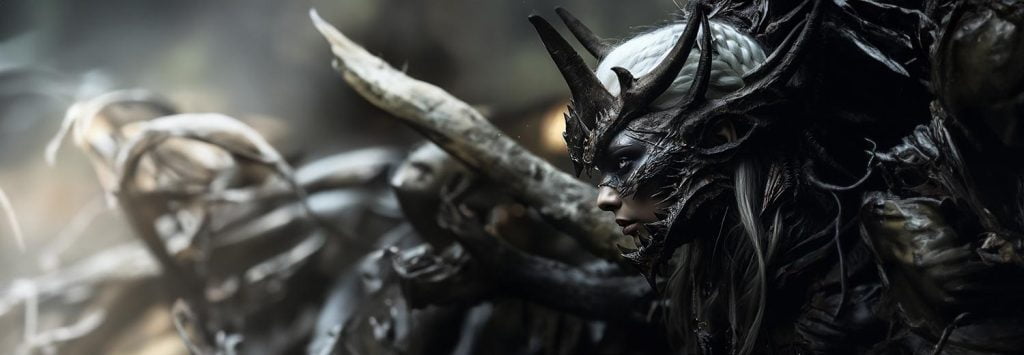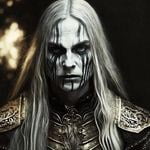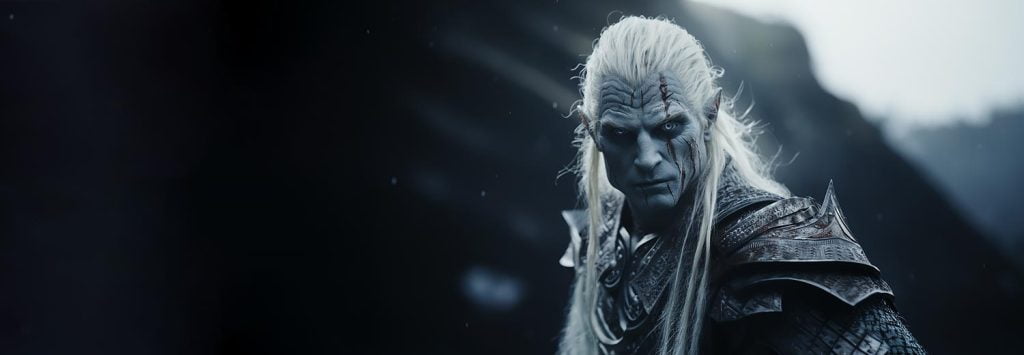Introduction to the Mysterious World of Dark Elves
Welcome to the fascinating world of Dark Elves, those enigmatic beings who have found their home in the depths of fantasy literature. When we hear the word “Dark Elf,” we are inevitably transported to a world where magic and myth go hand in hand, and where these unique creatures play a central role.
Dark Elves, also known as Drow have secured their place in fantasy literature, captivating readers around the globe. Their story stretches far back, imbued with rich mythology and cultural influences that have evolved over centuries. They often embody the darker aspects of the Elven worlds we know and love from classic tales. But what exactly makes a Dark Elf? How do they differ from their lighter counterparts, the High Elves, and what role do they play in the narratives in which they appear?
In this chapter, we take a look at the origins and significance of Dark Elves. We explore their role in fantasy literature and how they differentiate from other mythological creatures, and especially how the Dark Elves at Valtyr not only differ from other depictions but also why they do so. From ancient legends to their modern portrayals in books and films, Dark Elves remain a source of fascination and mystery. Let’s dive into their world and uncover the secrets that make them so special.
Significance of Dark Elves in Fantasy Literature
In the realm of fantasy, Dark Elves have carved out a significant niche that has continually expanded over decades. They are much more than mere side characters – Dark Elves embody a complexity and depth that sets them apart from other mythological beings. Their portrayal ranges from noble yet tragically misguided beings to cunning antagonists, making them a source of endless inspiration for authors and artists alike.
The allure of Dark Elves lies in their ambivalence. They are neither purely evil nor entirely good, which grants them a unique position in fantasy literature. This multidimensionality makes Dark Elves ideal characters for intricate narratives where themes such as morality, power, and identity are explored.
As we delve deeper into this article, we will explore the world of Dark Elves, uncovering their origins, and discovering what makes them so distinctive at Valtyr.
Mythological Roots
The story of Dark Elves begins in the rich tapestry of mythology. Rooted in ancient folklore, these beings often emerged as powerful figures in the mythic traditions of various cultures. In Norse mythology, for example, Dark Elves, known as ‘Dökkálfar‘, were depicted as beings dwelling in the underworld, contrasting with the ‘Ljósálfar‘, or Light Elves, of the heavens. These early interpretations highlight the dualistic nature of Dark Elves, poised between the realms of light and shadow.
Development Across Cultures
As tales of Dark Elves traversed cultures, their characteristics evolved, absorbing elements from each society’s beliefs and folklore. In some traditions, they were seen as malevolent, while in others, they were more nuanced, often reflecting the complexities of the human condition. This cultural journey enriched the Dark Elf archetype, allowing it to become a versatile and multifaceted character in modern fantasy literature.
Characteristics of a Dark Elf
In contemporary fantasy, Dark Elves are often portrayed with distinctive physical traits – typically having dark or obsidian skin, white or silver hair, and piercing eyes. Their aesthetic is not just about appearance; it symbolizes their connection to the darker elements of magic and the world they inhabit. Intellectually and emotionally, Dark Elves are depicted as intelligent, cunning, and often morally ambiguous. This complexity makes them intriguing characters, capable of both benevolent actions and malevolent schemes.
The portrayal of Dark Elves varies significantly across different fantasy worlds. In some narratives, they are fierce warriors, skilled in combat and strategy. In others, they are powerful sorcerers with mastery over dark magic. Regardless of their role, Dark Elves consistently captivate audiences with their depth, mystery, and the inevitable intrigue they bring to any story.
Development Across Cultures & Unique Aspects in Valtyr’s Aereathor
As tales of Dark Elves traversed cultures, their characteristics evolved, absorbing elements from each society’s beliefs and folklore. In some traditions, they were seen as malevolent, while in others, they were more nuanced, often reflecting the complexities of the human condition. This cultural journey enriched the Dark Elf archetype, allowing it to become a versatile and multifaceted character in modern fantasy literature.
A unique interpretation of this evolution is vividly portrayed in the realm of Aereathor in Valtyr’s narrative. Here, we encounter the Dark Elf tribes, who can be described as the descendants of the original Dark Elves, the Eldthari of Varlagh, fitting the traditional Dark Elf narratives. However, the Dark Elves of Aereathor have distinct differences. For instance, they no longer possess the bluish skin of their ancestors, and not all retain the iconic white-silver hair. Generations removed from their original bloodline; they still maintain a unity with their ancient kin.
The Dark Elves of Aereathor are particularly distinguished by their black and white war paint, visible on their faces, an emblem of ancient traditions. This paint, often maintained even in daily life, symbolizes many vital aspects of their values, caution, and culture. Originally rooted in magic and serving as a deterrent against strangers and foes, this practice remains a significant part of their identity, showcasing a unique evolution within the Dark Elf archetype.

Dark Elves in Modern Fantasy Literature & Well-Known Examples from Books and Films
In contemporary fantasy, Dark Elves often embody a more sinister counterpart to traditional High Elves. This is evident in the influential works of J.R.R. Tolkien’s “The Lord of the Rings”, where Elves are portrayed as tall, human-like beings of otherworldly beauty, setting a standard for their depiction in modern fiction. This contrast is further explored in various books and films, where Dark Elves are featured with their unique attributes and complex storylines.
Some famous Dark Elves and related movies include:
Drizzt Do’Urden – A renowned character from R.A. Salvatore’s “Forgotten Realms” series, Drizzt is one of the most iconic Dark Elf characters in fantasy literature.
Malekith the Accursed – Featured in Marvel Comics and the movie “Thor: The Dark World,” Malekith is the ruler of the Dark Elves of Svartalfheim.
The Drow of Dungeons & Dragons – Popularized in various Dungeons & Dragons campaigns and literature, the Drow are a classic example of Dark Elves.
Eol and Morathi in Warhammer Universe – In the Warhammer fantasy series, these characters are prominent figures among the Dark Elves or Druchii.
These characters and their associated movies or series have played a significant role in shaping the modern portrayal of Dark Elves in fantasy media.
Dark Elves in Games
In the world of gaming, Dark Elves have a significant presence.
Dark Elves, also known as Dunmer, are a prominent race in “The Elder Scrolls V: Skyrim,” a popular action role-playing video game developed by Bethesda Game Studios. In the lore of “The Elder Scrolls” series, the Dunmer are known for their dark skin and red eyes. They hail from the province of Morrowind and are recognized for their strong magical abilities and natural resistance to fire.
In “Skyrim“, the Dunmer play a significant role both in terms of gameplay and in the game’s narrative. Players can choose to play as a Dark Elf, benefiting from their specific racial abilities and skills. Additionally, the game’s story and world-building include various elements related to Dunmer culture, history, and their integration into the diverse societies of the game’s world, particularly following the eruption of the Red Mountain in Morrowind, which led many Dunmer to seek refuge in Skyrim. The city of Windhelm, for instance, features a significant population of Dunmer, who live in a segregated quarter known as the Gray Quarter, reflecting the racial tensions present in the game’s storyline.
The classic tabletop RPG “Dungeons & Dragons” is notable for its introduction of the Drow, a subrace of Dark Elves known for their cunning and association with darkness. This portrayal has influenced many other fantasy games. The Warhammer universe, too, presents Dark Elves (or Druchii) as formidable and often malevolent beings, known for their martial prowess and dark sorcery. Other notable appearances include the “Elder Scrolls” series, “EverQuest“, and “Final Fantasy“, each offering a unique take on Dark Elf lore and culture.
Contrasts with Traditional Elves
Compared to traditional Elves, Dark Elves in modern fantasy and gaming are usually associated with darker themes. Traditional Elves, depicted as wise and in harmony with nature, stand in stark contrast to Dark Elves, who are often linked with underground realms and a more menacing presence. This difference is not just physical but also extends to moral and philosophical dimensions, with Dark Elves often portrayed as more complex and morally ambiguous, adding layers to the traditional Elf archetype.
Social Structure and Hierarchies
The society of Dark Elves is often depicted as complex and governed by strict hierarchies. These societies are typically matriarchal, with powerful female leaders, or dominated by an elite warrior caste. Intrigue and power struggles are common in their culture, emphasizing the value placed on loyalty and strength. Such structures highlight the political and social complexity of the Dark Elves, offering deep insights into their distinctive worldview.
In the world of Aereathor, Dark Elves view hierarchies as unwritten laws, deeply ingrained in their society. Central to their culture is a strong sense of unity, with a focus on maintaining personal honor and upholding ancient traditions. Mutual respect is highly valued, and there is no distinction between women and men in daily life, combat, or politics, reflecting a society that cherishes equality and collective strength.
However, intriguing exceptions exist within this societal fabric, such as the Norathari in the north of Aereathor. This group is a unique subset of Dark Elves, governed exclusively by women and known for their xenophobic tendencies. The Norathari represent a distinct cultural branch within the larger Dark Elf community, illustrating the diversity and complexity of societal norms among Aereathor’s Dark Elves.
Comment:
As a creator, author, and lover of Dark Fantasy, I view Dark Elves as far more than just characters; they are meaningful symbols that reflect and challenge both human nature and society. They embody the complexity of our desires and moral ambiguities, urging us to delve deeper into the intricacies of good and evil. To me, Dark Elves are a mirror showing the layered nature of our world, encouraging us to question our own beliefs, values, and perhaps even our own history. Their presence in the fantasy world is not just for entertainment; it’s a thoughtful exploration of the human condition.
Anyone who delves into the world of Aereathor and the story of Valtyr is invited to try to look behind the scenes and ask themselves questions they wouldn’t normally consider in everyday life. For me, the story in its complexity was never just a fictional fantasy spectacle where one finds oneself on a wondrous, sometimes dark, and even terrifying adventure journey, but something existent, which we can probably only grasp or comprehend through detours of our mind.



